Пир с Олимпийскими играми
«Нет другой звезды благороднее солнца, дающей столько тепла и блеска в пустыне неба.
Так и мы прославляем те, что из всех игр благородней, - Олимпийские игры».
[Пиндар (конец VI-V в. до н.э.), беотийский поэт, самый знаменитый из девяти лириков]
Древнегреческие пиршественные сосуды из Британского музея, украшенные сценами состязаний атлетов на играх, не только Олимпийских. И фрагмент из «Занимательной Греции» Гаспарова.
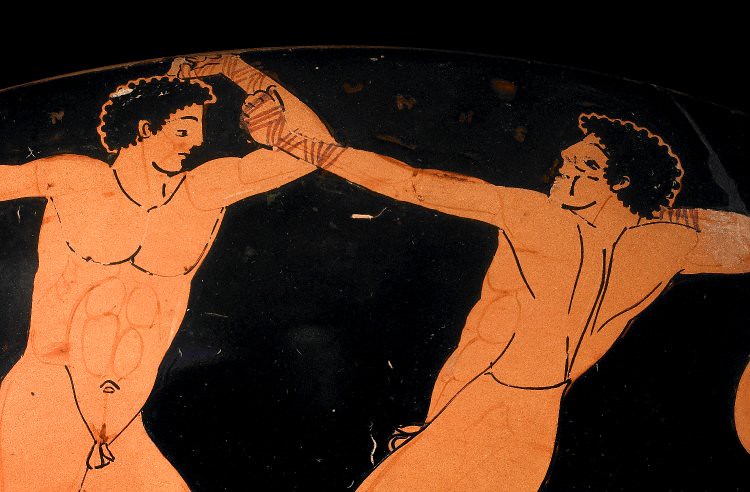
Kylix. 490-480 BC (circa). Attica. Museum number 1850,0302.2. British Museum
"Год 1300. Геракл, очистив Авгиевы конюшни и победив царя Авгия, учредил Олимпийские игры.
Год 1260. Тесей, убив Минотавра, освободил Афины от дани, дал им законы и учредил Истмийские игры.
Год 1251. Поход Семерых против Фив, и тогда же учреждены Немейские игры". Так в пересчете летосчисления следует из древней мраморной хронологической таблицы, сохранившейся на острове Паросе.
Об античных Олимпийских играх - академик Михаил Леонович Гаспаров, перечитывать которого всегда приятно. Из книги «Занимательная Греция: Рассказы о древнегреческой культуре»:
Год 776 до н.э. - первые Олимпийские игры.
2.
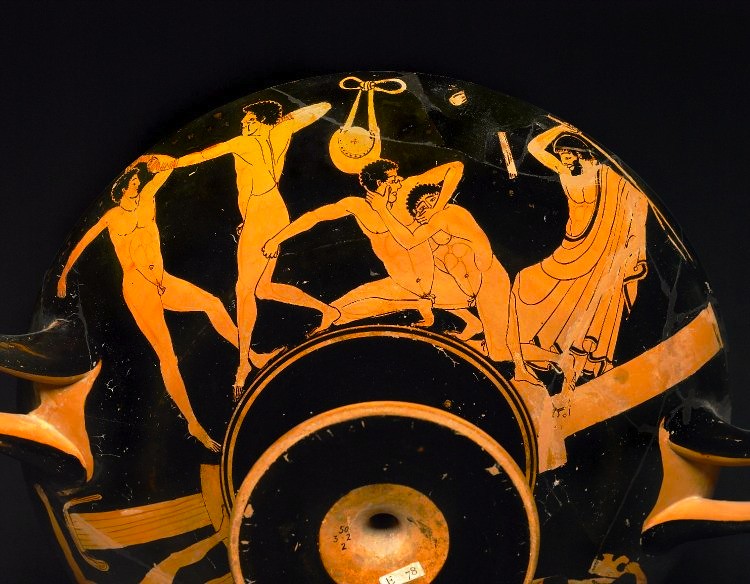
Kylix showing wrestlers. 490-480 BC (circa). Pottery: red-figured kylix. Attributed to: The Foundry Painter. Made in: Attica. Findspot Excavated/Findspot: Vulci (Italy, Lazio, Viterbo (province), Vulci). Dimensions Height: 123 millimeters Diameter: 318 millimeters. Width: 395 millimetres (including handles). Weight: 946 grammes. Height: 12.7 centimeters. Diameter: 30.48 centimetres. Inscription: Ο […] ΕΟΣΕΣΕΟΣΝ, ΝΕΝΟΝΝΟΕΟ. Museum number 1850,0302.2. British Museum. Source. [Description]
INTERIOR: Trainer and boxer. A bearded trainer stands to the right, but looks back over his shoulder to the left. He wears a himation (black border; battlement border around shoulder only), shoes and a red apicate fillet in his hair (tails at back). The hair down the median line of his stomach is done with irregular short strokes in dilute glaze. He holds a forked stick out in his right hand; his left is within a bunch of drapery behind his back. On the right stands a naked athlete tying a thong (drawn in relief lines) around his raised right hand and wrist. His left leg is frontal, his right leg flexed behind his left with only the toes touching the ground. He has a red apicate fillet in his hair (tails at back). Preliminary sketch reveals that the trainer's arm was originally intended to have been bent up at 90°, holding his stick vertically.
Border: dotted cross-squares alternating with three units of stopt maeander (anticlockwise); additional maeander unit at 10 o'clock.
EXTERIOR: athletes.
Side A (upper): boxers and pancratiasts. On the left is a pair of boxers in a bout. The boxer on the left has his left arm bent up in front, his right arm back, and there is a dilute line on his cheek. His opponent, facing to the left, is seen in three-quarter back view, his left arm out in front, his right drawn back for a blow. His cheek is heavily marked with relief lines, under the eye and along the cheekbone, to denote swelling. The thongs of both boxers around their hands and wrists are painted in red. In the centre is a pair of pancratiasts down on the ground. On the left, the youth has his torso frontal, his right leg tucked up under resting on the ball of the foot and partially obscuring his genitals, his left leg outstretched to the right. His head is turned to the right, his right arm is out to the left, fist clenched to deliver a blow, his left holds his opponent's head in an armlock, his fingers seeming to claw at his opponent's right eye and the palm and heel of his hand covering his mouth. He has a relief line marking his cheekbone and two dilute creases on his brow. His opponent has a frontal face. His legs are wrapped round the first youth's left leg and he has both hands to that youth's face, his thumbs probably searching for his right eye. Above them hangs a discus in a bag - the discus is decorated with a cross and the mouth of the bag with dots - and a pair of thongs. On the right a bearded trainer steps forward, his forked stick raised over his head to stop the fouls and the fight. He is dressed in a himation (black border) and shoes; his left arm is under the himation. On the far right is a column with a plain one step base and a plain termination at the top.
Side Β (lower): hoplitodromos and boxers. On the left a hoplitodromos moves to the right, wearing greaves and a thick reserved fillet round his head. He carries a shield on his left arm and holds a helmet down in his right hand (missing fragment had part of crest and calf of this figure and, on the inside, part of the maeander border). In front of him stands a trainer, whose torso and left leg are fully frontal, but his inclined head is turned to the right. He wears a himation (black border) and a red wreath and holds a forked stick in his right hand, his left arm akimbo under the himation. In the centre a pair of boxers fight with open hands. They both have red thongs around their hands and wrists and the outlines of the cheeks are marked with dilute lines. The boxer on the left has both legs frontal. His left arm is extended in a defensive position, while with his right he wards off the left arm of his opponent. The boxer on the right has his left arm out in front and his right arm bent up over his head; part of his back is visible. Behind him hangs a pair of thongs. On the right stands a boxer holding a red thong stretched between his two hands. His right leg is frontal and his left is turned to the right, but his head faces back to the left. On the far right is a pillar with fluting done in dilute glaze, a plain single step base and plain termination on top, on which rests a pair of thongs. Ground line: two closely set reserved lines. Graffito under foot.
Relief line contour throughout (except hair); dilute glaze for minor interior markings; thick reserved line lip, thin outside; added red for inscriptions.
Inscription Comment (Nonsense, Es with their three strokes facing downwards).
" Олимпийские игры
Не надо путать Олимпию и Олимп. Олимп - это гора в северной Греции, высокая, скалистая, со снежной вершиной, окутанной туманом; говорили, что там живут боги. А Олимпия - это городок в южной Греции, в Пелопоннесе, в области Элиде: зеленая дубовая роща, посвященная Зевсу, при роще - храм Зевса, а при храме - место для знаменитых олимпийских состязаний.
3.
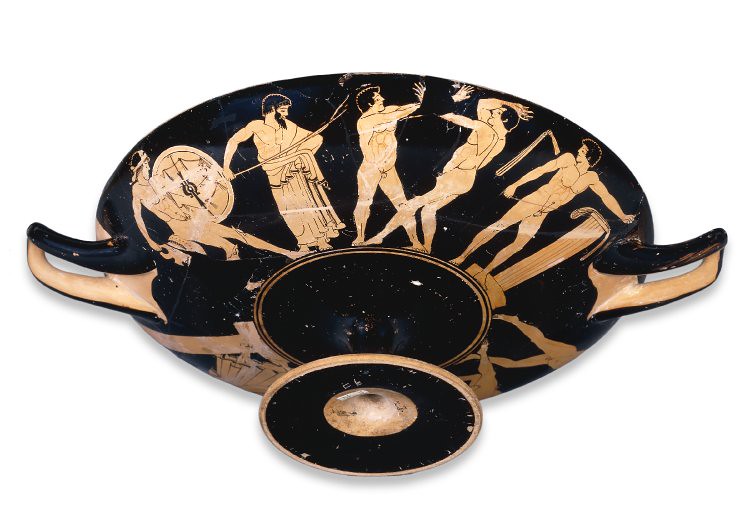
Kylix. 490-480 BC (circa). Attica. Museum number 1850,0302.2. British Museum
Покорив Аркадию и Арголиду, Спарта могла без труда покорить и Элиду с Олимпией, но поступила умней. Она объявила Олимпию нейтральной землей и взяла на себя ее защиту. Раз в четыре года, в пору летнего солнцестояния, по всей Греции объявлялось священное перемирие: все войны прекращались, и в Олимпию по всем дорогам стекались толпы народа - участвовать в состязаниях или поглядеть на состязания. В остальное время греки чувствовали себя только гражданами своих маленьких городов-государств, вечно ссорившихся друг с другом. Здесь, в Олимпии, они чувствовали себя сыновьями единого народа.
4.

Kylix. Pottery: red-figured kylix. 510-500 BC (circa). Made in: Attica. Museum number 1837,0609.74. British Museum
Таких общегреческих праздников, сопровождавшихся священным перемирием, было четыре: кроме Олимпийских, это были Пифийские в Дельфах, Истмийские в Коринфе и Немейские в тех местах, где Геракл когда-то убил каменного льва. Но Олимпийские считались самыми древними.
5.
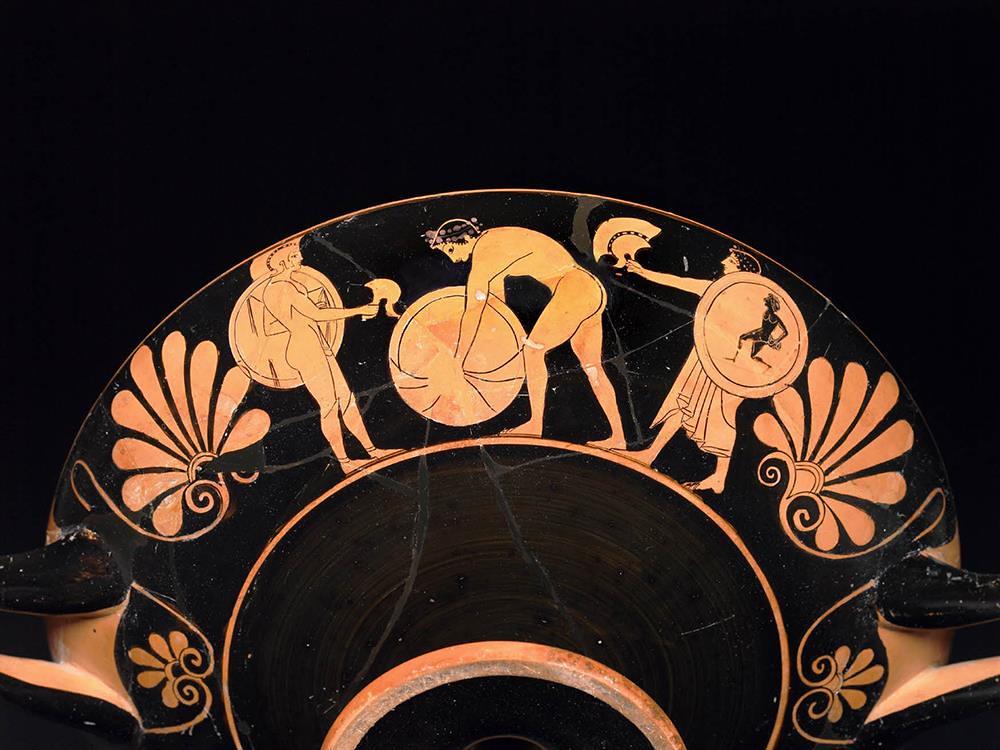
Kylix. Pottery: red-figured kylix. 510-500 BC (circa). Made in: Attica. Height: 125 millimetres. Diameter: 328 millimetres. Width: 415 millimetres (including handles). Weight: 1156 grammes. Height: 12.7 centimetres. Diameter: 33.02 centimetres. Condition Much broken. Museum number 1837,0609.74. British Museum. Source. [Description]Interior: Within a thin red circle, an Hoplitodromos (?) running at full speed to right, looking back: his back is to front, his shield extended to left (no device), his right arm bent and pointing downwards; his helmet is tilted back, and he wears greaves. The top of his helmet is cut off by the border. His feet rest on the border.
Exterior: (a) Ephebi arming for Hoplitodromia (race-in-armour). In the centre a youth wreathed bends forward to left, taking with both hands a shield from its case (σάγμα). On his left stands a youth already equipped like the figure in interior, holding out the crestless helmet of the central figure in his right. On the right a third youth, wreathed and wearing an himation, advances with a shield (device, a wreathed jumper holding halteres behind him, running to left) on his left arm, holding out in his right a crested helmet towards the central figure.
(b) Four beardless warriors charging. They run in single file to left, with left foot on ground, right raised; each has his spear raised horizontally over his right shoulder, and wears helmet tilted back, shield (device, a tripod on a ground-line) and greaves.
Purple is used for the wreaths; no inner markings. The shield device in a is in the regular black-figure technique, with incised lines and purple wreath: this figure runs upon a ground-line in light brown; the tripods are, as usual, in silhouette. The ear is indicated merely by a space in the hair, and has no details. Below each handle a small palmette, from which a large one branches out on each side; in b, this palmette overlaps the foremost figure on left.
Состязания были посвящены Зевсу Олимпийскому: считалось, что богу приятно смотреть на людскую силу и ловкость. Но какие именно проявления силы и ловкости людям нужнее всего - это решалось самыми земными привычками. Что должен уметь пастух, чтобы уберечь свое стадо от разброда, волков и разбойников? Нагнать хищников, перескочить через расселину, издали уметить в противника камнем или палкою, изблизи вступить с ним в драку и одолеть.
6.

Kylix. Pottery: red-figured kylix. 510-500 BC (circa). Made in: Attica. Museum number 1837,0609.74. British Museum
Отсюда и программа ранних олимпийских состязаний: бег, прыжок в длину, метание диска и копья, борьба. Лишь потом к ним добавились скачки верхом и в колесницах, а бег и борьба разделились на несколько разновидностей.
7.
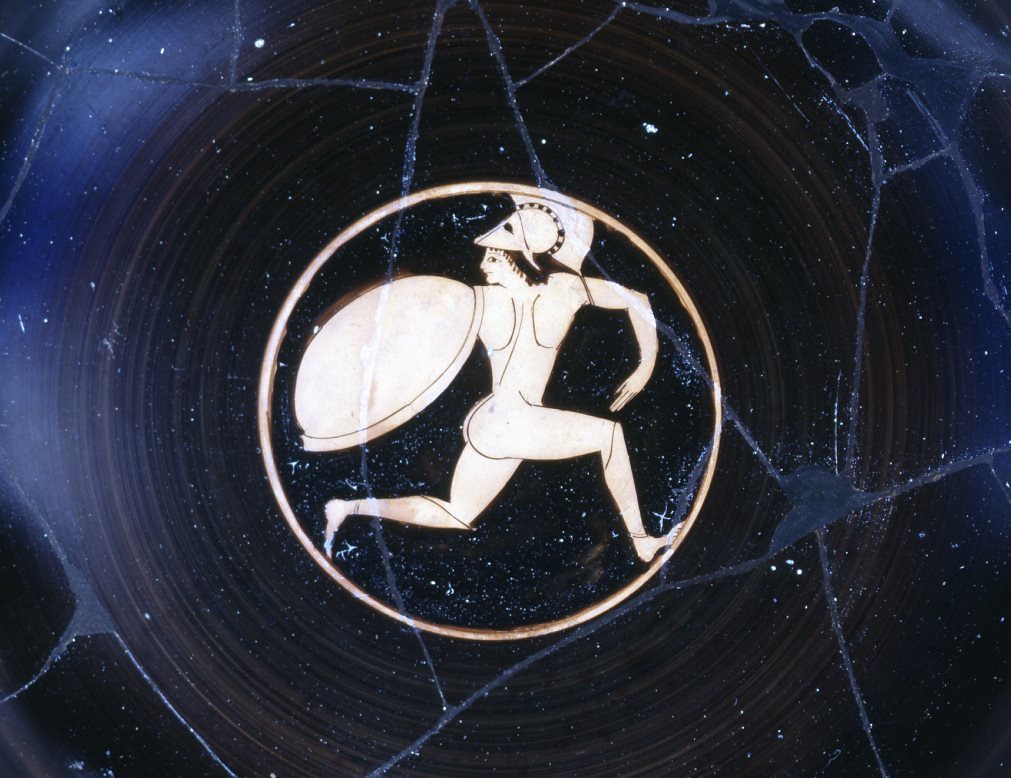
Kylix. Pottery: red-figured kylix. 510-500 BC (circa). Made in: Attica. Museum number 1837,0609.74. British Museum
Рекордные результаты не отмечались, смотрели только, «кто раньше» или «кто дальше». Поэтому лишь в редких случаях мы можем сравнивать достижения греческих атлетов с нынешними. Бегун Тисандр пробежал за час около 19 км - это очень хороший показатель и для современного бегуна. Дискобол Флегий перебросил диск через олимпийскую речку Алфей - это около 50 м по нашему счету, достижение международного класса, а ведь греческие диски были обычно тяжелее наших. Камень с надписью «Бибон поднял меня над головою одной рукой» весит 143,5 кг - это очень большой вес для двух рук и почти невообразимый для одной. Атлет Фаилл сделал прыжок в длину на 16 м - это почти вдвое дальше современных рекордов, и многие считают такой успех легендой; но здесь сравнивать трудно, потому что греки прыгали иначе, чем мы, - они почти не разбегались, зато они держали в руках гири-гантели, чтобы придать телу дополнительную инерцию, а в наши дни такая техника разработана мало.
8.

Amphora showing scene from a chariot race. Greece, 500-480 BC. British Museum. Source
Наградой в Олимпии был только оливковый венок, а в Дельфах - лавровый. Но эта награда означала, что носитель ее - любимец бога, даровавшего ему победу на своих играх. И его чтили и славили как любимца бога. В честь его устраивались праздники, воздвигались статуи, слагались песни.
9.

Panathenaic amphora. 500-480 BC. Pottery: black-figured Panathenaic amphora. Made in: Attica. Height: 63.5 centimetres. Inscription: ΤΟΝΑΘΕΝEΘΕΝΑΘΛΟΝ (των 'Aθη'νηθεν άθλων). Inscription Translation: One of the prizes from Athens. Museum number 1837,0609.75. British Museum. Source. [Description]Designs black on red panels, with incised lines and purple and white accessories. On the obverse the panel is continuous with the neck of the vase; on the reverse it is separated by a black border. On the neck, double honeysuckle pattern.
(a) Athene to left, between two Doric columns, each surmounted by a cock; left foot advanced, brandishing her lance in right hand; long hair, long sleeveless chiton with purple spots, and aegis with scales and fringe of snakes, the folds of the chiton being indicated; high-crested helmet with purple fillet, and on left arm a shield with the device of Pegasos to left, painted white. Inscribed.
(b) Chariot-race: A biga driven at full speed to right; its driver is bearded, with close-fitting white drawers, and bends forward, holding reins in right hand and goad in left; his feet rest on a footboard suspended from the pole.
Особенно знамениты были те, кто подряд одерживал победы на всех четырех общегреческих играх - Немейских, Истмийских, Пифийских, Олимпийских. Знаменитый родосский борец Диагор сам был таким четверным победителем и двух сыновей своих видел такими четверными победителями; а когда подросли его внуки, тоже одержали победу в Олимпии и в ответ на приветствия народа подхватили на плечи своего-доблестного деда и понесли по стадиону, то народ от восторга себя не помнил, а один спартанец крикнул: «Теперь умри, Диагор: на земле ничего славнее уже нет, а на небо тебе все равно не взойти!»
10.

Amphora. 550-540BC (circa). Pottery: black-figured amphora. Made by: Nikosthenes (potter). Made in: Attica. Excavated/Findspot: Agrigento (Italy, Sicily). Height: 21.59 centimetres. Museum number 1867,0508.968. British Museum. Source. [Description]Designs black on deep buff ground, with a band of network below; accessories of purple. Handles thin and grooved; under each, a palmette and lotus pattern.
On the neck: (a) Two wrestlers about to engage, nude and bearded. On either side a brabeus (adjudicator) looking on, bearded, with long hair, fillet, embroidered himation, and wand in hand, (b) Two athletes, nude and bearded, boxing, each with caestus (gauntlet) on both hands; both are spitting blood. On either side, a brabeus, as last.
On the body: (a) Two athletes boxing, nude and bearded, with caestus on their hands; the one on the left bleeds heavily at the nose; the other from a wound in the forehead. Between them is inscribed: NIKOΣΘENEΣEΠOIEΣEN, Νικοσθένης εποίησεν. (b) Two wrestlers, each grasping the other's right arm, nude and bearded.
Олимпийские атлеты
Греки любили свои спортивные состязания без памяти. На Олимпийские игры народ сходился толпами. Справлялись они в самом разгаре лета; давка и жара была такая, что один хозяин, говорят, грозил провинившемуся рабу: «Вот пошлю я тебя не жернова ворочать, а в Олимпию на игры смотреть!» Имена победителей в соревнованиях были у всех на устах. Об атлетах ходило множество рассказов - иногда восторженных, иногда насмешливых.
11.

Amphora. Pottery: black-figured amphora. Date 550-540 BC (circa). Made in: Attica. Made by: Nikosthenes (potter). Height: 21.59 centimetres. Museum number 1867,0508.968. British Museum. Source
Самым знаменитым атлетом всех времен был Милон Кротонский, ученик философа Пифагора. Это он мальчиком стал тренировать силу, поднимая на плечи теленка и каждый день обнося его вокруг площадки для упражнений. Теленок рос, но росли и силы Милона; прошло года три, и он с такой же легкостью носил вокруг стадиона большого быка.
12.

Amphora. Pottery: black-figured amphora. Date 550-540 BC (circa). Museum number 1867,0508.968. British Museum
Когда Милон одержал победу, в честь его отлили бронзовую статую в полный рост; он вскинул ее на плечо и сам принес в храм. Забавлялся он тем, что брал в пальцы гранатовое яблоко и предлагал его вырвать у него; никто не мог, а между тем держал он его так легко, что гранат оставался нераздавленным. Забавлялся он и тем, что обвязывал себе голову веревкой, а потом вздувал жилы на висках и рвал веревку, не коснувшись ее руками. Забавлялся и тем, что протягивал руку дощечкой и предлагал отвести мизинец от других пальцев; никто не мог.
13.
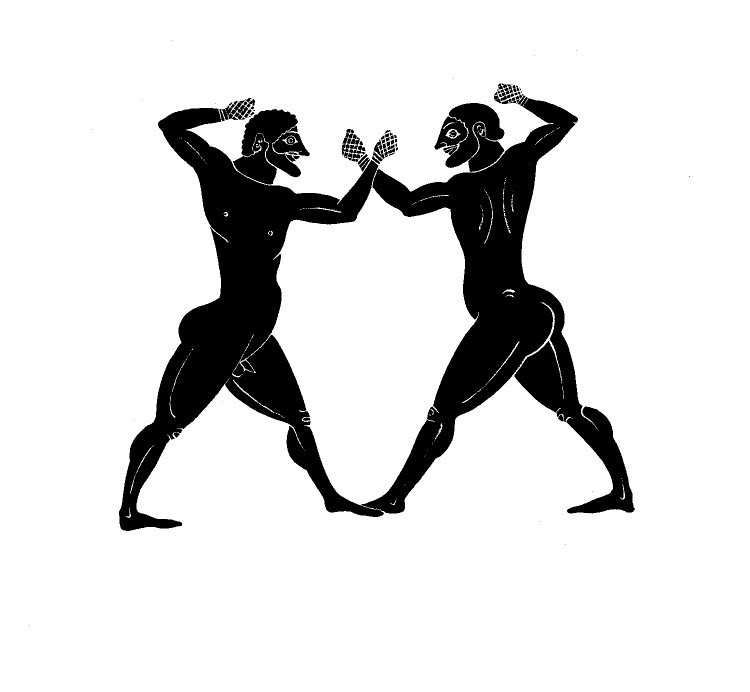
Amphora. Pottery: black-figured amphora. Date 550-540 BC (circa). Museum number 1867,0508.968. British Museum
Он погиб, когда гулял в лесу и увидел дерево, расщепленное молнией; для потехи он решил разломать дерево надвое, но был уже стар, не рассчитал силы, руки его защемило в расщепе, и он не мог их вырвать; и когда пришел дикий лев и набросился на него, Милон оказался беззащитен.
14.

Amphora. 530-500 BC (circa). Pottery amphora decorated in the Fikellura style with a running man. Attributed to: The Running Man Painter. Made in: Miletus. Height: 34 centimetres. Width: 28.5 centimetres. Weight: 2 kilograms. Museum number 1864,1007.156. British Museum. Source. [Description]Neck, triple cable. Shoulder, chain of simplified pomegranates, joined alternately. The diameter of the mouth is 0.16 m. from back to front, 0.135 m. between the handles: some pinching is common in Fikellura, but this is the extreme instance so far as is known.
Другой атлет, Полидамант, с голыми руками ходил на льва, подражая Гераклу; хватая быка за ногу, он отрывал ему копыто; останавливал на бегу колесницу, запряженную четверней; приглашенный к персидскому царю, убил там в единоборстве трех царских гвардейцев - из тех, которые у персов зовутся «бессмертными». Он погиб, когда сидел с товарищами в пещере и над ними вдруг треснул и стал обваливаться свод; товарищи бросились прочь, но Полидамант счел это позорным, остался, подпер обвал плечами и был засыпан.
15.

Amphora. 530-500 BC (circa). Museum number 1864,1007.156. British Museum
Атлет Феаген одержал 1400 побед. Это значит, что у него было 1400 побежденных соперников, и все они ему завидовали. Когда Феаген умер, один из них приходил по ночам к статуе Феагена (всем олимпийским победителям ставили статуи) и хлестал ее бичом. Статуя упала и задавила хлеставшего. Статую обвинили в убийстве, судили и бросили в море. На следующий год настал неурожай, начались моровые болезни; граждане обратились к оракулу, и прорицательница-пифия велела им вернуть всех изгнанников. Граждане объявили всем изгнанникам дозволение вернуться, но мор не кончался. Опять пошли к оракулу, пифия сказала: «Забыли Феагена». Статую вытащили сетями из моря, поставили на место, устроили в честь ее празднество, и все кончилось благополучно.
16.
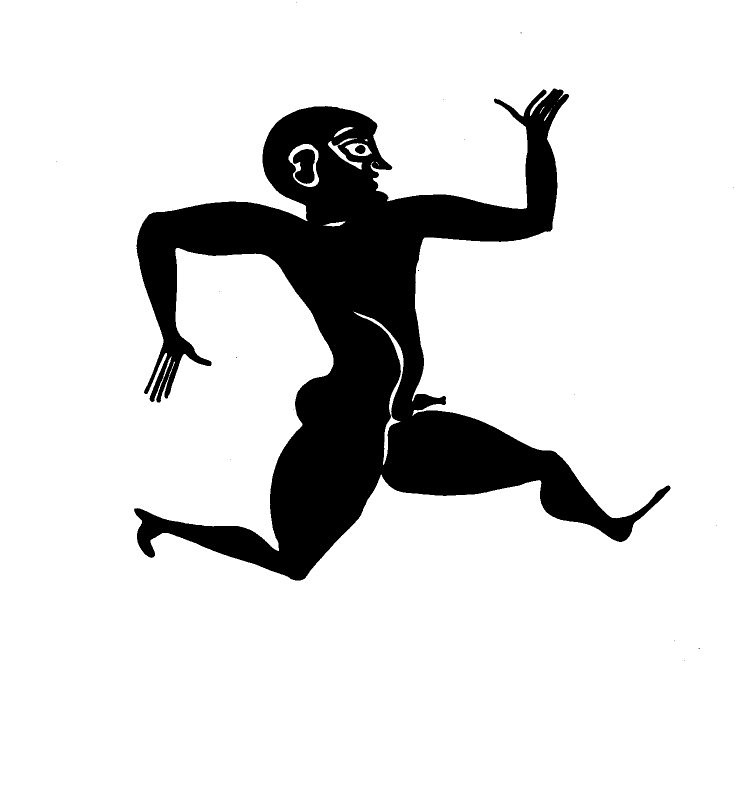
Amphora. 530-500 BC (circa). Museum number 1864,1007.156. British Museum
Атлет Главк был крестьянский сын. Отец, увидав, как он голыми руками вбивает в соху сошник, привел его в Олимпию. Начался кулачный бой. Главка стали бить, а он стоял и терпел, опасаясь не в меру зашибить противника. Отец из публики крикнул ему: «Бей, как по плугу!». Главк развернулся и ударил, и победа осталась за ним.
17.

Amphora. 530-500 BC (circa). Museum number 1864,1007.156. British Museum
У атлета Демократа заболели ноги, а отказаться от состязаний он не хотел. Он пришел в Олимпию, встал среди поля и предложил столкнуть или стащить его с места. Никто не смог. Демократу присудили победу.
18.

Prize/trophy. Panathenaic amphora. 500-490 BC (circa). Pottery: black-figured Panathenaic prize-amphora. Made in: Attica. Excavated/Findspot: Vulci (said to be)(Italy, Lazio). Height: 65 centimetres. Diameter: 40 centimeters. Weight: 9.1 kilograms (approx). Inscription: ΤΟΝΑΘΕΝEΘΕΝΑΘΛΟΝ (των 'Aθη'νηθεν άθλων). Inscription Translation: One of the prizes from Athens. Museum number 1836,0224.193. British Museum. Source. [Description]Designs black on red panels, as last. (a) Athene to left between two Doric columns; earrings, bracelets, long embroidered chiton with folds rudely indicated, and aegis with snakes; high-crested helmet with purple fillet, and shield with device of a serpent to left painted white. Inscribed.
(b) Horse-race: Two nude youths with long hair, the hinder one wearing a fillet with ends floating behind, on horseback to right, riding at full speed. Each has a three-thonged whip, the foremost brandishing his, the further holding his downwards; the bridles and bits are marked by incised lines.
На скачках кобыла наездника Фидола сбросила седока, но продолжала скачку и пришла первой. Фидол был объявлен победителем - за то, что у него такая хорошая лошадь.
19.
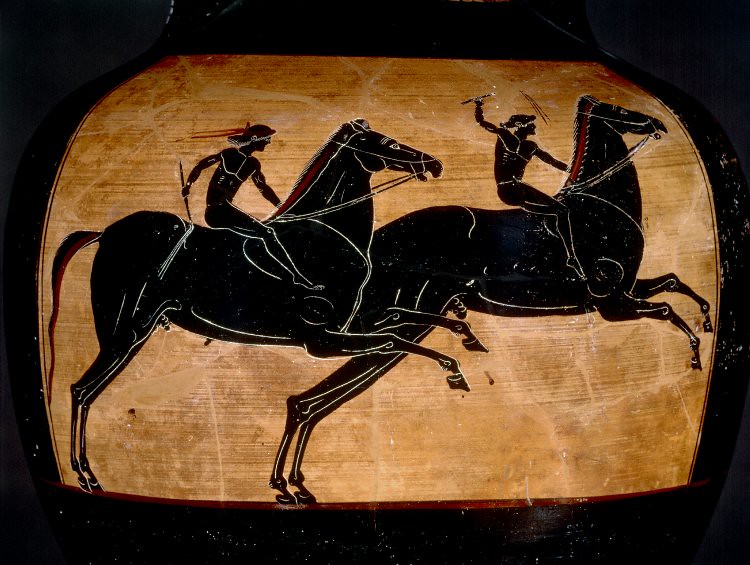
Black-figured Panathenaic prize-amphora. 500-490 BC (circa). Museum number 1836,0224.193. British Museum
Атлет Аполлоний опоздал в Олимпию, потому что выступал за деньги за морем, но признаться в этом он постеснялся и сказал, что его задержали встречные ветры. Он вступил в состязания, вышел победителем, получил венок, но тут обман его раскрылся, венок с него сняли и возложили на его соперника. Аполлоний тут же набросился на соперника с кулаками, тот бросился бежать с венком на голове; кому присудить победу, так и осталось нерешенным.
20.

Cup showing athletics. 470-460 BC. Pottery: red-figured cup. Interior: woman. Exterior: athletes. Painted by: The Cat and Dog Painter (probably). Made in: Attica. Height: 9.6 centimetres. Diameter: 23.5 centimetres. Museum number 1928,0117.59. British Museum. Source
Обман в Олимпии наказывался сурово: возле стадиона стояли в ряд статуи Зевса, сооруженные только на штрафы, собранные с нарушителей. Один атлет хотел воспользоваться тем, что его соперник Эгмий был отроду немой, и подкупил судью, чтобы тот подсудил в его пользу, думая, что Эгмий не сможет пожаловаться. Но Эгмий, увидев это, пришел в такое негодование, что вскрикнул и впервые в жизни заговорил.
21.
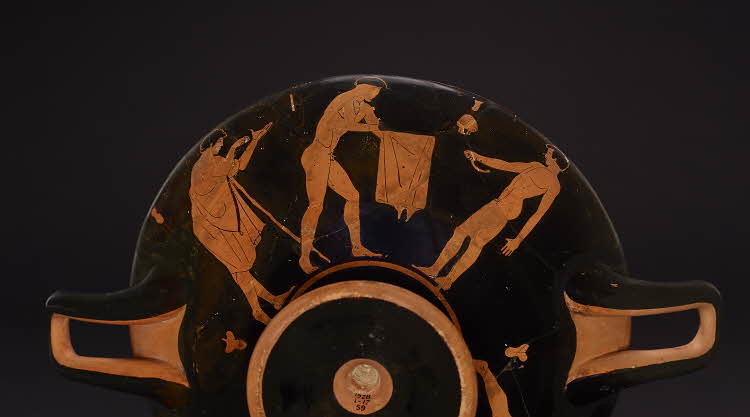
Cup. 470-460 BC. Museum number 1928,0117.59. British Museum
А вообще олимпийские судьи судили честно. Перед состязанием они должны были проверять лошадей, допускаемых к скачкам, и давали при этом две клятвы: во-первых, судить по совести и, во-вторых, никому не объяснять, почему они судили так, а не иначе. Греки нанимали, что бывают и такие случаи, когда правильное решение чувствуешь, а объяснить не можешь. "
22.
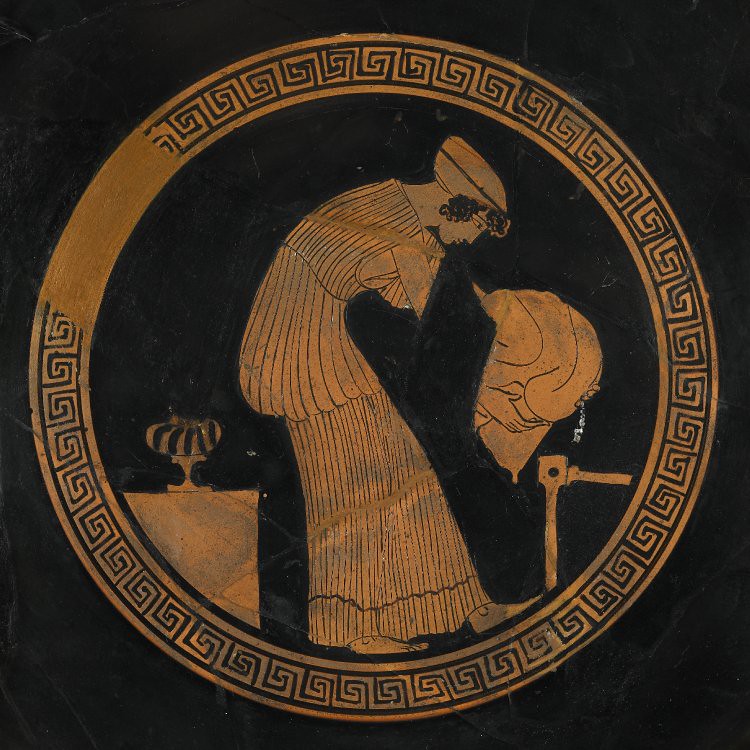
Cup. 470-460 BC. Museum number 1928,0117.59. British Museum
Летосчисление
" <…> Вам, наверное, не раз приходилось читать: «Греки так чтили Олимпийские игры, что вели свое летосчисление по олимпиадам». Так вот, это неверно. Счет времени по олимпиадам («В 3-й год 72-й олимпиады греки победили персов при Марафоне...») вели некоторые греческие историки, чтобы уследить за длинным рядом событий. Но это была их кабинетная выдумка, и не более того. Ни в одном документе, ни в одной надписи таких дат не было. Греки не вели летосчисления по олимпиадам, они не вели вообще никакого летосчисления. Годы в их сознании были не нанизаны на тянущуюся нить, а как бы рассыпаны пестрой неподвижной россыпью. "
23.

Panathenaic amphora. 332-331 BC. Pottery: black-figured Panathenaic amphora. Made in: Attica. Excavated/Findspot: Capua (Italy, Campania). Height: 77 centimetres. Width: 37.5 centimetres. Weight: 6 kilograms. Museum number 1873,0820.370. British Museum. Source. [Description]Free style, with few archaisms. Designs on panels with accessories of white and buff. On the neck, double honeysuckle-pattern.
(a) Athene standing to right between two Doric columns, with left foot advanced, spear in right hand, and shield with wave-border on left arm. She has earrings, bracelets and a necklace of pendants, picked out in buff; high-crested helmet ornamented with volutes, and aegis, of which only the Gorgoneion and two white cross-bands remain; long chiton with diploidion, and himation. On each column is a Nike turned to the front, standing on the prow of a ship on which two eyes are incised; she has wings outspread, a wreath, white chiton, and himation leaving the upper part of the body nude, and holds out a wreath in both hands. Down the side of the column on the right is an inscription. Down the side of the other column is a further inscription.
(b) Pankration (wrestling): An athlete to right, nude and bearded, with face turned to the front, has the head of a similar athlete to left in his left arm, and is about to strike him with his right hand; the other tries to release his head. On the left is an ephedros (odd contestant with a bye to the next round), nude and beardless, turned to the front, with right hand on hip; on the right is a brabeus (adjudicator) to left, with face turned half to the front, wearing a white wreath and himation, right hand holding out a palm-branch, in left a wreath.
Фрагменты из книги: Михаил Гаспаров. Занимательная Греция: Рассказы о древнегреческой культуре. - М.: Греко-латинский кабинет, Новое литературное обозрение, 1996. Стр. 7-8, 31-34, 36. pdf: НЛО, 2000
Цитата из Пиндара по: Глеб Иванович Соколов. Олимпия. - М.: Искусство, 1980. С. 8.
Дополнительно см.: The British Museum: Ancient Olympics - modern Olympics
24.
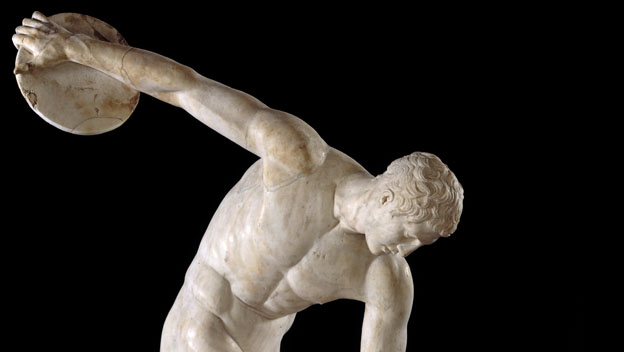
Discus-thrower. Italy, Roman copy of original from the 400s BC. Source
А сейчас не так как в Античности. В дни Олимпиад теперь, люди говорят, принято инциденты затевать и международные конфликты начинались, но может быть это просто злые языки и совпадения.
Так и мы прославляем те, что из всех игр благородней, - Олимпийские игры».
[Пиндар (конец VI-V в. до н.э.), беотийский поэт, самый знаменитый из девяти лириков]
Древнегреческие пиршественные сосуды из Британского музея, украшенные сценами состязаний атлетов на играх, не только Олимпийских. И фрагмент из «Занимательной Греции» Гаспарова.

Kylix. 490-480 BC (circa). Attica. Museum number 1850,0302.2. British Museum
"Год 1300. Геракл, очистив Авгиевы конюшни и победив царя Авгия, учредил Олимпийские игры.
Год 1260. Тесей, убив Минотавра, освободил Афины от дани, дал им законы и учредил Истмийские игры.
Год 1251. Поход Семерых против Фив, и тогда же учреждены Немейские игры". Так в пересчете летосчисления следует из древней мраморной хронологической таблицы, сохранившейся на острове Паросе.
Об античных Олимпийских играх - академик Михаил Леонович Гаспаров, перечитывать которого всегда приятно. Из книги «Занимательная Греция: Рассказы о древнегреческой культуре»:
Год 776 до н.э. - первые Олимпийские игры.
2.

Kylix showing wrestlers. 490-480 BC (circa). Pottery: red-figured kylix. Attributed to: The Foundry Painter. Made in: Attica. Findspot Excavated/Findspot: Vulci (Italy, Lazio, Viterbo (province), Vulci). Dimensions Height: 123 millimeters Diameter: 318 millimeters. Width: 395 millimetres (including handles). Weight: 946 grammes. Height: 12.7 centimeters. Diameter: 30.48 centimetres. Inscription: Ο […] ΕΟΣΕΣΕΟΣΝ, ΝΕΝΟΝΝΟΕΟ. Museum number 1850,0302.2. British Museum. Source. [Description]
INTERIOR: Trainer and boxer. A bearded trainer stands to the right, but looks back over his shoulder to the left. He wears a himation (black border; battlement border around shoulder only), shoes and a red apicate fillet in his hair (tails at back). The hair down the median line of his stomach is done with irregular short strokes in dilute glaze. He holds a forked stick out in his right hand; his left is within a bunch of drapery behind his back. On the right stands a naked athlete tying a thong (drawn in relief lines) around his raised right hand and wrist. His left leg is frontal, his right leg flexed behind his left with only the toes touching the ground. He has a red apicate fillet in his hair (tails at back). Preliminary sketch reveals that the trainer's arm was originally intended to have been bent up at 90°, holding his stick vertically.
Border: dotted cross-squares alternating with three units of stopt maeander (anticlockwise); additional maeander unit at 10 o'clock.
EXTERIOR: athletes.
Side A (upper): boxers and pancratiasts. On the left is a pair of boxers in a bout. The boxer on the left has his left arm bent up in front, his right arm back, and there is a dilute line on his cheek. His opponent, facing to the left, is seen in three-quarter back view, his left arm out in front, his right drawn back for a blow. His cheek is heavily marked with relief lines, under the eye and along the cheekbone, to denote swelling. The thongs of both boxers around their hands and wrists are painted in red. In the centre is a pair of pancratiasts down on the ground. On the left, the youth has his torso frontal, his right leg tucked up under resting on the ball of the foot and partially obscuring his genitals, his left leg outstretched to the right. His head is turned to the right, his right arm is out to the left, fist clenched to deliver a blow, his left holds his opponent's head in an armlock, his fingers seeming to claw at his opponent's right eye and the palm and heel of his hand covering his mouth. He has a relief line marking his cheekbone and two dilute creases on his brow. His opponent has a frontal face. His legs are wrapped round the first youth's left leg and he has both hands to that youth's face, his thumbs probably searching for his right eye. Above them hangs a discus in a bag - the discus is decorated with a cross and the mouth of the bag with dots - and a pair of thongs. On the right a bearded trainer steps forward, his forked stick raised over his head to stop the fouls and the fight. He is dressed in a himation (black border) and shoes; his left arm is under the himation. On the far right is a column with a plain one step base and a plain termination at the top.
Side Β (lower): hoplitodromos and boxers. On the left a hoplitodromos moves to the right, wearing greaves and a thick reserved fillet round his head. He carries a shield on his left arm and holds a helmet down in his right hand (missing fragment had part of crest and calf of this figure and, on the inside, part of the maeander border). In front of him stands a trainer, whose torso and left leg are fully frontal, but his inclined head is turned to the right. He wears a himation (black border) and a red wreath and holds a forked stick in his right hand, his left arm akimbo under the himation. In the centre a pair of boxers fight with open hands. They both have red thongs around their hands and wrists and the outlines of the cheeks are marked with dilute lines. The boxer on the left has both legs frontal. His left arm is extended in a defensive position, while with his right he wards off the left arm of his opponent. The boxer on the right has his left arm out in front and his right arm bent up over his head; part of his back is visible. Behind him hangs a pair of thongs. On the right stands a boxer holding a red thong stretched between his two hands. His right leg is frontal and his left is turned to the right, but his head faces back to the left. On the far right is a pillar with fluting done in dilute glaze, a plain single step base and plain termination on top, on which rests a pair of thongs. Ground line: two closely set reserved lines. Graffito under foot.
Relief line contour throughout (except hair); dilute glaze for minor interior markings; thick reserved line lip, thin outside; added red for inscriptions.
Inscription Comment (Nonsense, Es with their three strokes facing downwards).
" Олимпийские игры
Не надо путать Олимпию и Олимп. Олимп - это гора в северной Греции, высокая, скалистая, со снежной вершиной, окутанной туманом; говорили, что там живут боги. А Олимпия - это городок в южной Греции, в Пелопоннесе, в области Элиде: зеленая дубовая роща, посвященная Зевсу, при роще - храм Зевса, а при храме - место для знаменитых олимпийских состязаний.
3.

Kylix. 490-480 BC (circa). Attica. Museum number 1850,0302.2. British Museum
Покорив Аркадию и Арголиду, Спарта могла без труда покорить и Элиду с Олимпией, но поступила умней. Она объявила Олимпию нейтральной землей и взяла на себя ее защиту. Раз в четыре года, в пору летнего солнцестояния, по всей Греции объявлялось священное перемирие: все войны прекращались, и в Олимпию по всем дорогам стекались толпы народа - участвовать в состязаниях или поглядеть на состязания. В остальное время греки чувствовали себя только гражданами своих маленьких городов-государств, вечно ссорившихся друг с другом. Здесь, в Олимпии, они чувствовали себя сыновьями единого народа.
4.

Kylix. Pottery: red-figured kylix. 510-500 BC (circa). Made in: Attica. Museum number 1837,0609.74. British Museum
Таких общегреческих праздников, сопровождавшихся священным перемирием, было четыре: кроме Олимпийских, это были Пифийские в Дельфах, Истмийские в Коринфе и Немейские в тех местах, где Геракл когда-то убил каменного льва. Но Олимпийские считались самыми древними.
5.

Kylix. Pottery: red-figured kylix. 510-500 BC (circa). Made in: Attica. Height: 125 millimetres. Diameter: 328 millimetres. Width: 415 millimetres (including handles). Weight: 1156 grammes. Height: 12.7 centimetres. Diameter: 33.02 centimetres. Condition Much broken. Museum number 1837,0609.74. British Museum. Source. [Description]Interior: Within a thin red circle, an Hoplitodromos (?) running at full speed to right, looking back: his back is to front, his shield extended to left (no device), his right arm bent and pointing downwards; his helmet is tilted back, and he wears greaves. The top of his helmet is cut off by the border. His feet rest on the border.
Exterior: (a) Ephebi arming for Hoplitodromia (race-in-armour). In the centre a youth wreathed bends forward to left, taking with both hands a shield from its case (σάγμα). On his left stands a youth already equipped like the figure in interior, holding out the crestless helmet of the central figure in his right. On the right a third youth, wreathed and wearing an himation, advances with a shield (device, a wreathed jumper holding halteres behind him, running to left) on his left arm, holding out in his right a crested helmet towards the central figure.
(b) Four beardless warriors charging. They run in single file to left, with left foot on ground, right raised; each has his spear raised horizontally over his right shoulder, and wears helmet tilted back, shield (device, a tripod on a ground-line) and greaves.
Purple is used for the wreaths; no inner markings. The shield device in a is in the regular black-figure technique, with incised lines and purple wreath: this figure runs upon a ground-line in light brown; the tripods are, as usual, in silhouette. The ear is indicated merely by a space in the hair, and has no details. Below each handle a small palmette, from which a large one branches out on each side; in b, this palmette overlaps the foremost figure on left.
Состязания были посвящены Зевсу Олимпийскому: считалось, что богу приятно смотреть на людскую силу и ловкость. Но какие именно проявления силы и ловкости людям нужнее всего - это решалось самыми земными привычками. Что должен уметь пастух, чтобы уберечь свое стадо от разброда, волков и разбойников? Нагнать хищников, перескочить через расселину, издали уметить в противника камнем или палкою, изблизи вступить с ним в драку и одолеть.
6.

Kylix. Pottery: red-figured kylix. 510-500 BC (circa). Made in: Attica. Museum number 1837,0609.74. British Museum
Отсюда и программа ранних олимпийских состязаний: бег, прыжок в длину, метание диска и копья, борьба. Лишь потом к ним добавились скачки верхом и в колесницах, а бег и борьба разделились на несколько разновидностей.
7.

Kylix. Pottery: red-figured kylix. 510-500 BC (circa). Made in: Attica. Museum number 1837,0609.74. British Museum
Рекордные результаты не отмечались, смотрели только, «кто раньше» или «кто дальше». Поэтому лишь в редких случаях мы можем сравнивать достижения греческих атлетов с нынешними. Бегун Тисандр пробежал за час около 19 км - это очень хороший показатель и для современного бегуна. Дискобол Флегий перебросил диск через олимпийскую речку Алфей - это около 50 м по нашему счету, достижение международного класса, а ведь греческие диски были обычно тяжелее наших. Камень с надписью «Бибон поднял меня над головою одной рукой» весит 143,5 кг - это очень большой вес для двух рук и почти невообразимый для одной. Атлет Фаилл сделал прыжок в длину на 16 м - это почти вдвое дальше современных рекордов, и многие считают такой успех легендой; но здесь сравнивать трудно, потому что греки прыгали иначе, чем мы, - они почти не разбегались, зато они держали в руках гири-гантели, чтобы придать телу дополнительную инерцию, а в наши дни такая техника разработана мало.
8.

Amphora showing scene from a chariot race. Greece, 500-480 BC. British Museum. Source
Наградой в Олимпии был только оливковый венок, а в Дельфах - лавровый. Но эта награда означала, что носитель ее - любимец бога, даровавшего ему победу на своих играх. И его чтили и славили как любимца бога. В честь его устраивались праздники, воздвигались статуи, слагались песни.
9.

Panathenaic amphora. 500-480 BC. Pottery: black-figured Panathenaic amphora. Made in: Attica. Height: 63.5 centimetres. Inscription: ΤΟΝΑΘΕΝEΘΕΝΑΘΛΟΝ (των 'Aθη'νηθεν άθλων). Inscription Translation: One of the prizes from Athens. Museum number 1837,0609.75. British Museum. Source. [Description]Designs black on red panels, with incised lines and purple and white accessories. On the obverse the panel is continuous with the neck of the vase; on the reverse it is separated by a black border. On the neck, double honeysuckle pattern.
(a) Athene to left, between two Doric columns, each surmounted by a cock; left foot advanced, brandishing her lance in right hand; long hair, long sleeveless chiton with purple spots, and aegis with scales and fringe of snakes, the folds of the chiton being indicated; high-crested helmet with purple fillet, and on left arm a shield with the device of Pegasos to left, painted white. Inscribed.
(b) Chariot-race: A biga driven at full speed to right; its driver is bearded, with close-fitting white drawers, and bends forward, holding reins in right hand and goad in left; his feet rest on a footboard suspended from the pole.
Особенно знамениты были те, кто подряд одерживал победы на всех четырех общегреческих играх - Немейских, Истмийских, Пифийских, Олимпийских. Знаменитый родосский борец Диагор сам был таким четверным победителем и двух сыновей своих видел такими четверными победителями; а когда подросли его внуки, тоже одержали победу в Олимпии и в ответ на приветствия народа подхватили на плечи своего-доблестного деда и понесли по стадиону, то народ от восторга себя не помнил, а один спартанец крикнул: «Теперь умри, Диагор: на земле ничего славнее уже нет, а на небо тебе все равно не взойти!»
10.

Amphora. 550-540BC (circa). Pottery: black-figured amphora. Made by: Nikosthenes (potter). Made in: Attica. Excavated/Findspot: Agrigento (Italy, Sicily). Height: 21.59 centimetres. Museum number 1867,0508.968. British Museum. Source. [Description]Designs black on deep buff ground, with a band of network below; accessories of purple. Handles thin and grooved; under each, a palmette and lotus pattern.
On the neck: (a) Two wrestlers about to engage, nude and bearded. On either side a brabeus (adjudicator) looking on, bearded, with long hair, fillet, embroidered himation, and wand in hand, (b) Two athletes, nude and bearded, boxing, each with caestus (gauntlet) on both hands; both are spitting blood. On either side, a brabeus, as last.
On the body: (a) Two athletes boxing, nude and bearded, with caestus on their hands; the one on the left bleeds heavily at the nose; the other from a wound in the forehead. Between them is inscribed: NIKOΣΘENEΣEΠOIEΣEN, Νικοσθένης εποίησεν. (b) Two wrestlers, each grasping the other's right arm, nude and bearded.
Олимпийские атлеты
Греки любили свои спортивные состязания без памяти. На Олимпийские игры народ сходился толпами. Справлялись они в самом разгаре лета; давка и жара была такая, что один хозяин, говорят, грозил провинившемуся рабу: «Вот пошлю я тебя не жернова ворочать, а в Олимпию на игры смотреть!» Имена победителей в соревнованиях были у всех на устах. Об атлетах ходило множество рассказов - иногда восторженных, иногда насмешливых.
11.

Amphora. Pottery: black-figured amphora. Date 550-540 BC (circa). Made in: Attica. Made by: Nikosthenes (potter). Height: 21.59 centimetres. Museum number 1867,0508.968. British Museum. Source
Самым знаменитым атлетом всех времен был Милон Кротонский, ученик философа Пифагора. Это он мальчиком стал тренировать силу, поднимая на плечи теленка и каждый день обнося его вокруг площадки для упражнений. Теленок рос, но росли и силы Милона; прошло года три, и он с такой же легкостью носил вокруг стадиона большого быка.
12.

Amphora. Pottery: black-figured amphora. Date 550-540 BC (circa). Museum number 1867,0508.968. British Museum
Когда Милон одержал победу, в честь его отлили бронзовую статую в полный рост; он вскинул ее на плечо и сам принес в храм. Забавлялся он тем, что брал в пальцы гранатовое яблоко и предлагал его вырвать у него; никто не мог, а между тем держал он его так легко, что гранат оставался нераздавленным. Забавлялся он и тем, что обвязывал себе голову веревкой, а потом вздувал жилы на висках и рвал веревку, не коснувшись ее руками. Забавлялся и тем, что протягивал руку дощечкой и предлагал отвести мизинец от других пальцев; никто не мог.
13.

Amphora. Pottery: black-figured amphora. Date 550-540 BC (circa). Museum number 1867,0508.968. British Museum
Он погиб, когда гулял в лесу и увидел дерево, расщепленное молнией; для потехи он решил разломать дерево надвое, но был уже стар, не рассчитал силы, руки его защемило в расщепе, и он не мог их вырвать; и когда пришел дикий лев и набросился на него, Милон оказался беззащитен.
14.

Amphora. 530-500 BC (circa). Pottery amphora decorated in the Fikellura style with a running man. Attributed to: The Running Man Painter. Made in: Miletus. Height: 34 centimetres. Width: 28.5 centimetres. Weight: 2 kilograms. Museum number 1864,1007.156. British Museum. Source. [Description]Neck, triple cable. Shoulder, chain of simplified pomegranates, joined alternately. The diameter of the mouth is 0.16 m. from back to front, 0.135 m. between the handles: some pinching is common in Fikellura, but this is the extreme instance so far as is known.
Другой атлет, Полидамант, с голыми руками ходил на льва, подражая Гераклу; хватая быка за ногу, он отрывал ему копыто; останавливал на бегу колесницу, запряженную четверней; приглашенный к персидскому царю, убил там в единоборстве трех царских гвардейцев - из тех, которые у персов зовутся «бессмертными». Он погиб, когда сидел с товарищами в пещере и над ними вдруг треснул и стал обваливаться свод; товарищи бросились прочь, но Полидамант счел это позорным, остался, подпер обвал плечами и был засыпан.
15.

Amphora. 530-500 BC (circa). Museum number 1864,1007.156. British Museum
Атлет Феаген одержал 1400 побед. Это значит, что у него было 1400 побежденных соперников, и все они ему завидовали. Когда Феаген умер, один из них приходил по ночам к статуе Феагена (всем олимпийским победителям ставили статуи) и хлестал ее бичом. Статуя упала и задавила хлеставшего. Статую обвинили в убийстве, судили и бросили в море. На следующий год настал неурожай, начались моровые болезни; граждане обратились к оракулу, и прорицательница-пифия велела им вернуть всех изгнанников. Граждане объявили всем изгнанникам дозволение вернуться, но мор не кончался. Опять пошли к оракулу, пифия сказала: «Забыли Феагена». Статую вытащили сетями из моря, поставили на место, устроили в честь ее празднество, и все кончилось благополучно.
16.

Amphora. 530-500 BC (circa). Museum number 1864,1007.156. British Museum
Атлет Главк был крестьянский сын. Отец, увидав, как он голыми руками вбивает в соху сошник, привел его в Олимпию. Начался кулачный бой. Главка стали бить, а он стоял и терпел, опасаясь не в меру зашибить противника. Отец из публики крикнул ему: «Бей, как по плугу!». Главк развернулся и ударил, и победа осталась за ним.
17.

Amphora. 530-500 BC (circa). Museum number 1864,1007.156. British Museum
У атлета Демократа заболели ноги, а отказаться от состязаний он не хотел. Он пришел в Олимпию, встал среди поля и предложил столкнуть или стащить его с места. Никто не смог. Демократу присудили победу.
18.

Prize/trophy. Panathenaic amphora. 500-490 BC (circa). Pottery: black-figured Panathenaic prize-amphora. Made in: Attica. Excavated/Findspot: Vulci (said to be)(Italy, Lazio). Height: 65 centimetres. Diameter: 40 centimeters. Weight: 9.1 kilograms (approx). Inscription: ΤΟΝΑΘΕΝEΘΕΝΑΘΛΟΝ (των 'Aθη'νηθεν άθλων). Inscription Translation: One of the prizes from Athens. Museum number 1836,0224.193. British Museum. Source. [Description]Designs black on red panels, as last. (a) Athene to left between two Doric columns; earrings, bracelets, long embroidered chiton with folds rudely indicated, and aegis with snakes; high-crested helmet with purple fillet, and shield with device of a serpent to left painted white. Inscribed.
(b) Horse-race: Two nude youths with long hair, the hinder one wearing a fillet with ends floating behind, on horseback to right, riding at full speed. Each has a three-thonged whip, the foremost brandishing his, the further holding his downwards; the bridles and bits are marked by incised lines.
На скачках кобыла наездника Фидола сбросила седока, но продолжала скачку и пришла первой. Фидол был объявлен победителем - за то, что у него такая хорошая лошадь.
19.

Black-figured Panathenaic prize-amphora. 500-490 BC (circa). Museum number 1836,0224.193. British Museum
Атлет Аполлоний опоздал в Олимпию, потому что выступал за деньги за морем, но признаться в этом он постеснялся и сказал, что его задержали встречные ветры. Он вступил в состязания, вышел победителем, получил венок, но тут обман его раскрылся, венок с него сняли и возложили на его соперника. Аполлоний тут же набросился на соперника с кулаками, тот бросился бежать с венком на голове; кому присудить победу, так и осталось нерешенным.
20.

Cup showing athletics. 470-460 BC. Pottery: red-figured cup. Interior: woman. Exterior: athletes. Painted by: The Cat and Dog Painter (probably). Made in: Attica. Height: 9.6 centimetres. Diameter: 23.5 centimetres. Museum number 1928,0117.59. British Museum. Source
Обман в Олимпии наказывался сурово: возле стадиона стояли в ряд статуи Зевса, сооруженные только на штрафы, собранные с нарушителей. Один атлет хотел воспользоваться тем, что его соперник Эгмий был отроду немой, и подкупил судью, чтобы тот подсудил в его пользу, думая, что Эгмий не сможет пожаловаться. Но Эгмий, увидев это, пришел в такое негодование, что вскрикнул и впервые в жизни заговорил.
21.

Cup. 470-460 BC. Museum number 1928,0117.59. British Museum
А вообще олимпийские судьи судили честно. Перед состязанием они должны были проверять лошадей, допускаемых к скачкам, и давали при этом две клятвы: во-первых, судить по совести и, во-вторых, никому не объяснять, почему они судили так, а не иначе. Греки нанимали, что бывают и такие случаи, когда правильное решение чувствуешь, а объяснить не можешь. "
22.

Cup. 470-460 BC. Museum number 1928,0117.59. British Museum
Летосчисление
" <…> Вам, наверное, не раз приходилось читать: «Греки так чтили Олимпийские игры, что вели свое летосчисление по олимпиадам». Так вот, это неверно. Счет времени по олимпиадам («В 3-й год 72-й олимпиады греки победили персов при Марафоне...») вели некоторые греческие историки, чтобы уследить за длинным рядом событий. Но это была их кабинетная выдумка, и не более того. Ни в одном документе, ни в одной надписи таких дат не было. Греки не вели летосчисления по олимпиадам, они не вели вообще никакого летосчисления. Годы в их сознании были не нанизаны на тянущуюся нить, а как бы рассыпаны пестрой неподвижной россыпью. "
23.

Panathenaic amphora. 332-331 BC. Pottery: black-figured Panathenaic amphora. Made in: Attica. Excavated/Findspot: Capua (Italy, Campania). Height: 77 centimetres. Width: 37.5 centimetres. Weight: 6 kilograms. Museum number 1873,0820.370. British Museum. Source. [Description]Free style, with few archaisms. Designs on panels with accessories of white and buff. On the neck, double honeysuckle-pattern.
(a) Athene standing to right between two Doric columns, with left foot advanced, spear in right hand, and shield with wave-border on left arm. She has earrings, bracelets and a necklace of pendants, picked out in buff; high-crested helmet ornamented with volutes, and aegis, of which only the Gorgoneion and two white cross-bands remain; long chiton with diploidion, and himation. On each column is a Nike turned to the front, standing on the prow of a ship on which two eyes are incised; she has wings outspread, a wreath, white chiton, and himation leaving the upper part of the body nude, and holds out a wreath in both hands. Down the side of the column on the right is an inscription. Down the side of the other column is a further inscription.
(b) Pankration (wrestling): An athlete to right, nude and bearded, with face turned to the front, has the head of a similar athlete to left in his left arm, and is about to strike him with his right hand; the other tries to release his head. On the left is an ephedros (odd contestant with a bye to the next round), nude and beardless, turned to the front, with right hand on hip; on the right is a brabeus (adjudicator) to left, with face turned half to the front, wearing a white wreath and himation, right hand holding out a palm-branch, in left a wreath.
Фрагменты из книги: Михаил Гаспаров. Занимательная Греция: Рассказы о древнегреческой культуре. - М.: Греко-латинский кабинет, Новое литературное обозрение, 1996. Стр. 7-8, 31-34, 36. pdf: НЛО, 2000
Цитата из Пиндара по: Глеб Иванович Соколов. Олимпия. - М.: Искусство, 1980. С. 8.
Дополнительно см.: The British Museum: Ancient Olympics - modern Olympics
24.

Discus-thrower. Italy, Roman copy of original from the 400s BC. Source
А сейчас не так как в Античности. В дни Олимпиад теперь, люди говорят, принято инциденты затевать и международные конфликты начинались, но может быть это просто злые языки и совпадения.